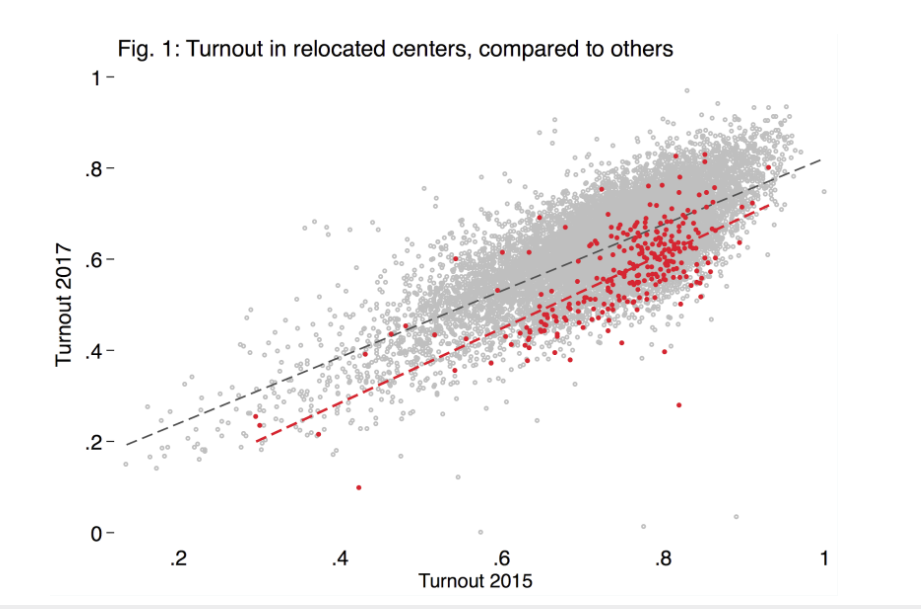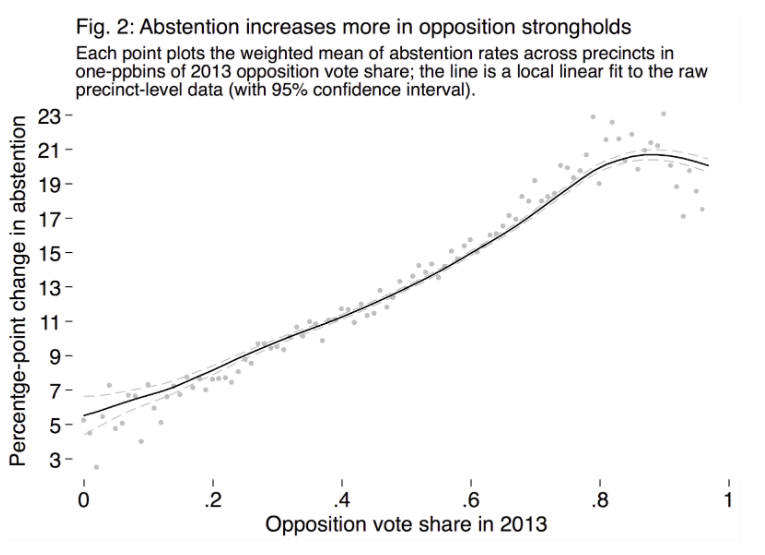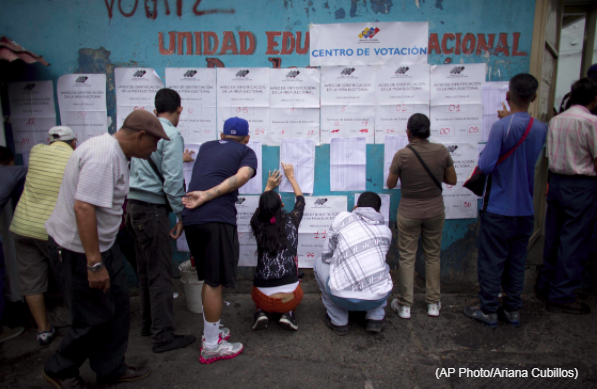Brexit. The Colombian referendum. Trump. And now, in Venezuela, another did-that-just-happen election result: on October 15, the wildly unpopular ruling coalition won 17 of 23 governorships.
This, just two years after the opposition trounced the ruling coalition in congressional elections. This, during the worst economic contraction in all of Latin American economic history, and with the president’s approval ratings in the low 20s.
Since the election, Venezuela and Venezuelanists have been asking: how did this happen?
Answers so far have focused on the electoral council’s dirty tricks—like moving polling stations at the last minute, or including on the ballot candidates who lost in the primaries, or handing out food near polling stations, or, most egregiously, the apparent tally fraud in Bolívar state.
These violations are real. And many others, like changing the date of the election, or signaling electoral council partisanship by texting voters the names of government candidates, had consequences that we can’t measure in the data.
But the electoral council maneuvers most featured in the press and in communications from the opposition coalition (MUD) do have effects that we can estimate, and, in our analysis, those consequences explain only about one percentage point of the government’s eight-point lead.
Consider the relocated precincts. Certainly, compared to 2015, turnout declined more in the 272 relocated precincts than in other, similar precincts (see Figure 1). But we estimate that, without these relocations, MUD would have obtained only an additional 23,000 votes (approximately)—while the governing coalition also would have done better, by about 3,300 votes. (See replication data and code for details on this exercise and all others reported in this article).
This means that precinct relocations account for only 0.2 percentage points of the government’s nationwide lead (see Table 1). Nor did the relocated precincts tip the balance toward the government candidate in any one state. In Miranda, MUD candidate Carlos Ocariz suggested that the relocated precincts might have cost him 88,000 votes; we estimate fewer than ten thousand.

Likewise, some confused voters cast ballots for opposition candidates who had lost in the primaries. But primary losers picked up just 92,105 votes nationwide, approximately 0.8% of votes overall. Adding these invalidated votes to MUD’s total would not have changed the electoral outcome in any state except Bolívar.
Some politicians have accused the electoral council of ballot stuffing: keeping precincts open late, kicking out opposition witnesses, and entering additional votes for the government. If so, we might expect the government to stuff as many ballots as possible. But nationwide, only 4,568 votes were cast for chavismo in voting machines with turnout higher than 90%. Subtract those votes from the government’s total, and the overall vote share changes by four hundredths of one percentage point.
Same goes for the tally fraud in Bolívar state: the government seems to have stolen that governorship, but the stolen votes account for just hundredths of a percentage point of the nationwide vote total.
Relative to the consequences of relocated precincts, primary losers on the ballot, potential ballot stuffing, or tally fraud in Bolívar, overall shifts in turnout were by far the biggest driver of the change in vote share since 2015.
This is evident from a simple comparison (in which we exclude Libertador votes from the 2015 totals, since there was no election in Libertador on Sunday):
| 2015 |
2017 |
|
| Government coalition | 5.1m | 5.8m |
| Opposition coalition | 7.0m | 5.0m |
Of course, this table alone doesn’t tell us how much of MUD’s electoral nosedive can be chalked up to turnout changes, compared to voters switching allegiances, and a serious estimate of the net effects of vote-switching relative to turnout changes is beyond the scope of this post. But survey data points away from vote-switching: of all the opposition and nini voters who participated in the MUD-organized protest vote on July 16, only 1% planned to vote for a government candidate last Sunday.
Moreover, precinct-level voting results show that abstention skyrocketed in opposition strongholds. Figure 2 plots the change in turnout between 2015 and and 2017 as a function of opposition vote share in the presidential election of 2013, using data from nearly 14,000 electoral precincts. (2013 was a high-turnout election, and thus provides as good a measure as any of political orientation.) In the most opposition neighborhoods, abstention increased by fifteen percentage points more than in the most oficialista neighborhoods.

A back-of-the-envelope calculation using these data suggests that, if turnout in last Sunday’s election had looked more like turnout in 2015, the opposition would have won more than one million additional votes, while the government would have picked up only half a million. That means that MUD would have had nearly 50% of the two-party vote nationwide—rather than 46%.
In other words, once we account for changes in turnout, the government’s lead falls from eight points to one.
Table 1 summarizes these results. We find that turnout shifts account for the bulk of chavismo’s lead, and that the consequences of these shifts are much larger than those of the electoral council’s ploys—at least, those with effects we can quantify.
TABLE 1: Sources of chavismo’s lead
See Appendix for a more detailed table and replication data.
| Estimated net votes for the government | Percentage of total votes | |
| Mobilization | 703,100 | 6.7% |
| Voting center relocations | 19,500 | 0.2% |
| Non-substitution of candidates | 92,100 | 0.9% |
| Total | 814,700 | 7.8% |
As others have noted, government mobilization efforts likely played a role in the differential change in turnout. In surveys taken before the election, 71% of respondents reported receiving food through the CLAPs, and the share of respondents who viewed the food supply situation as positive rose from 5.0% in July of last year to 23% in September. This might help explain the impressive turnout for oficialista candidates, even without direct vote-buying last Sunday.
Whatever the effect of government mobilization, meager opposition turnout also played a major role. So why did the opposition have such a hard time getting people to the polls?
Most obviously, some opposition leaders argued for boycotting the election. Perhaps the loudest voice in this chorus was hardliner María Corina Machado, and indeed, abstention increased more in precincts that supported Machado in opposition primaries. More generally, an opposition that has focused on regime change for three years had a hard time mobilizing voters for a gubernatorial election—since regime change wasn’t even on the table.
Then there’s messaging. After the Trump administration imposed financial sanctions on Venezuela, Maduro came out swinging, blaming opposition leaders for lobbying for sanctions and saying that “those who are happy because of sanctions are digging their own political grave.”
He may have been right: 70% of unaligned Venezuelan voters oppose U.S. sanctions, and Maduro’s approval ratings bounced 6% in the wake of the announcement, according to an October poll from Datanálisis. The same poll shows that rejection of sanctions rose by 10 points during the campaign. Despite this, opposition leaders quixotically refused to condemn sanctions.
That the opposition has this year suffered violent repression of protests and imprisonment of key leaders accounts for part of their disadvantage; that the electoral council also blatantly favored the government and actively discouraged opposition voters tilted the playing field even farther toward the ruling coalition. In July, electoral authorities destroyed what was left of their credibility by claiming that 8.1 million voters turned out in the Constitutional Convention elections, a figure that even chavistas had a hard time believing.
But the MUD also committed some of the same mistakes it has made in the past: boycotting elections; trying to block the government’s access to resources; and, perhaps most importantly, focusing on regime change instead of policy proposals. This week, opposition disunity came into focus, as Henrique Capriles threatened to withdraw from the MUD. As one popular provocateur put it, “The question that MUD should be asking, the question that everything depends on, is `Why can’t we embody the popular discontent?’”
Through the months of protests that racked the country earlier this year, opposition activists voiced a powerful slogan: el que se cansa pierde. Whoever tires first loses. The presumption was that hungry and demoralized government backers would tire before committed pro-democracy protesters. Perhaps. But the data suggests this hasn’t happened yet.
[Correction: the original post pointed to the impact of Trump Administration sanctions on government officials. Actually it was a reaction to financial sanctions.
Correction: the original post said “only 2,415 votes were cast for chavismo in voting machines with turnout higher than 90%,” amounting to “two hundredths of one percentage point.” This figure has been corrected to4,568 votes amounting to four hundredths of one percentage point.]



